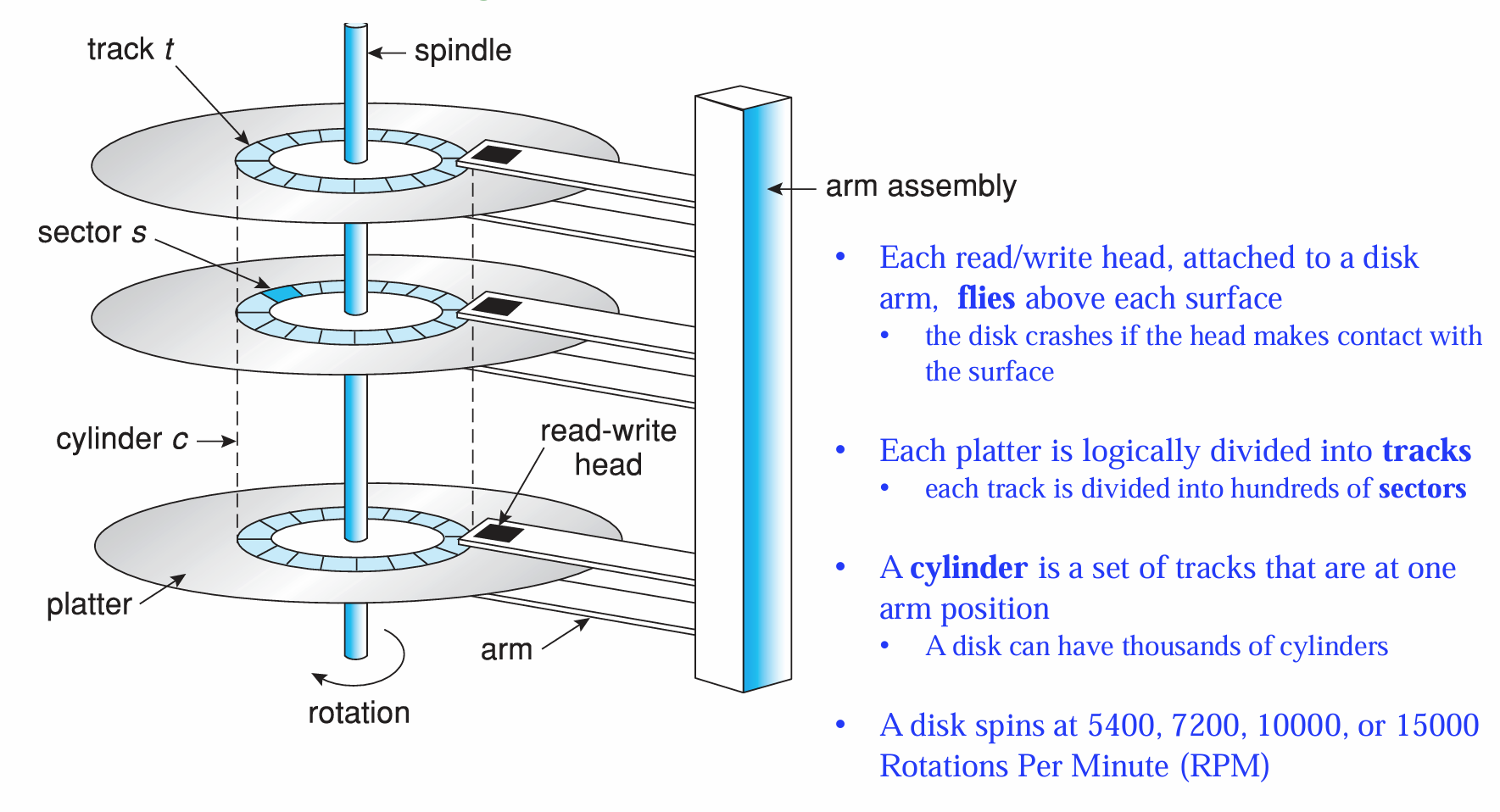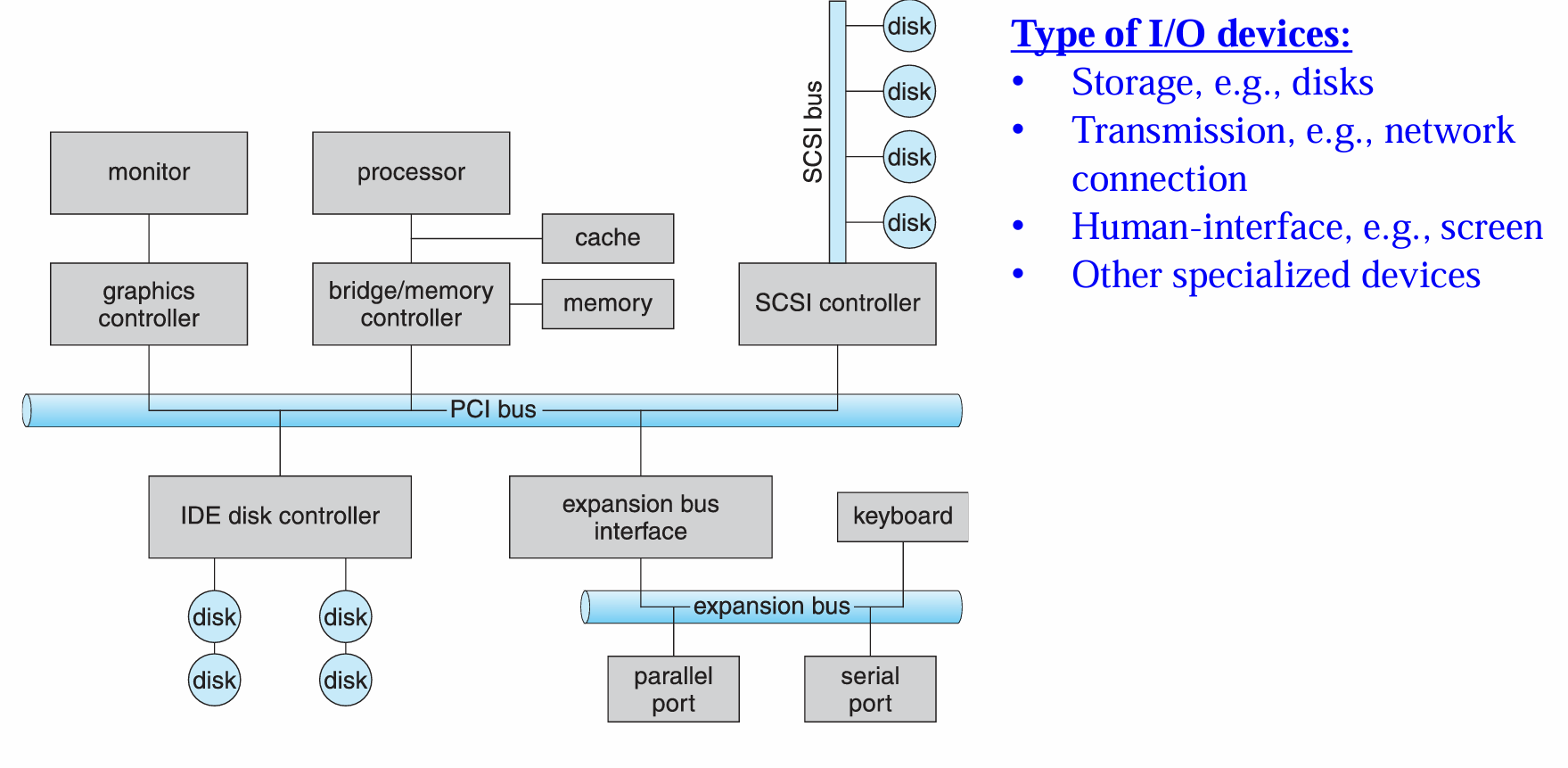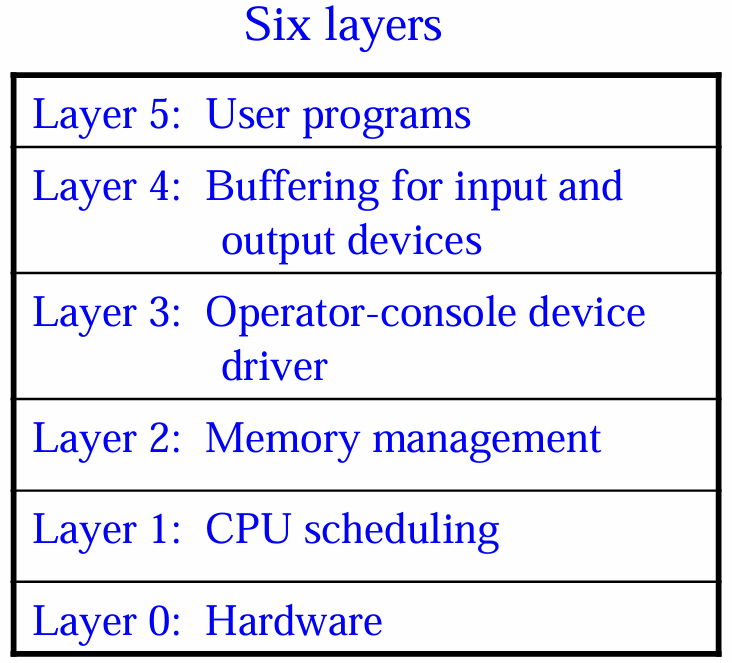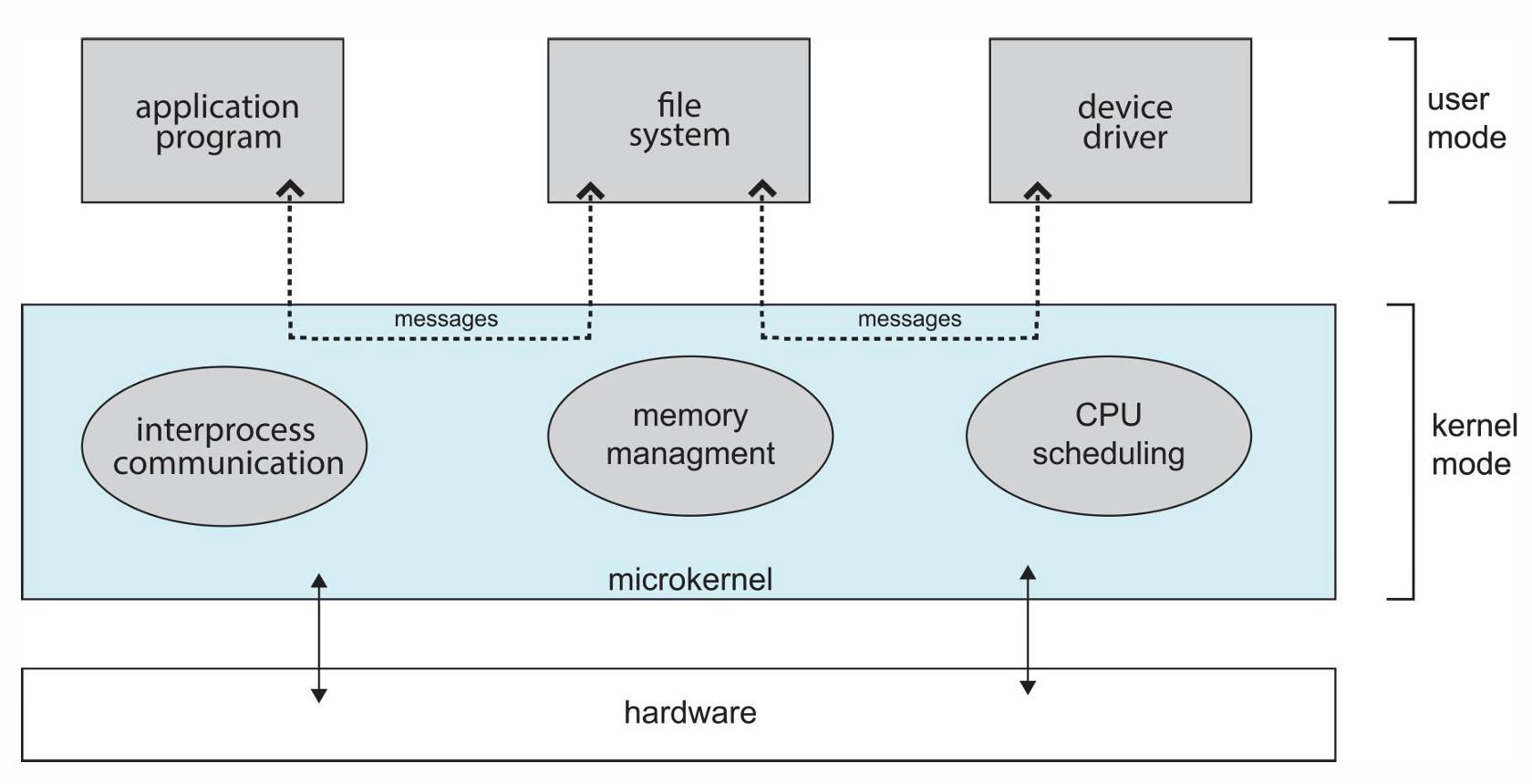Operating Systems Lecture 1
1/57
There's no tags or description
Looks like no tags are added yet.
Name | Mastery | Learn | Test | Matching | Spaced |
|---|
No study sessions yet.
58 Terms
What is an OS
An Operating System (OS) is a PROGRAM that acts as an interface between a USER of a computer system and the COMPUTERHARDWARE
What is a Kernal
a part of OS: a program that is running all the time on the computer
The kernel runs all the time and provides services to the system and its users.
- System programs are loaded and start running at boot time
- System programs that are running are called system processes or daemon.
Main Purpose of an OS
1) To provide an environment for a user to execute programs conveniently and efficiently
2) To simulate features not available on hardware
3) 3) To control all computer resources and provide the base at which the application programs can be written and run
What does a general purpose computer system contain?
One or more Central Processing Unit (CPU): the 'brain' of the system- Memory system- Input/output (I/O) devices, e.g., disks, printers
What is a bootstrap
An initial program to start running when a computer is powered on, and rebooted
-The bootstrap can be stored in a hardware (called firmware)
The bootstrap program initializes all aspects of computer system, e.g., CPU registers, Memory content, Device controllers
The bootstrap program knows how to locate the OS kernel, - The program will load kernel in memory, and run i
What is an interrupt mechanism?
The CPU waits for something to occur, the CPU stops what it is doing when it receives an 'interrupt'
It goes to a location to execute, the location is stored in an interrupt vector table.
Is an OS interrupt driven?
Yes
How does an interrupt work?
It goes to a specific location to execute the interrupt service routine (ISR), the location is stored in an interrupt vector table.
The table contains addresses and pointers of all ISR's
Each interrupt is known by an interrupt number, the lower the number the higher the priority.
The CPU resumes its execution on the completion of each ISR.
What is an interrupt controller?
Efficient interrupt handling is required for good system performance. The solution is to use a interrupt-controller hardware. It can defer interrupt handling during critical processing, it provides efficient dispatch to interrupt handler, it supports multi level interrupts with priority.
Thus the CPU can defer lower priority interrupts when a high priority is being served.
What are the 3 times the OS interacts with the interrupt mechanism? And what does it do?
1. At boot time: OS probes the hardware buses to see what devices are present and installs the required interrupt handlers into the interrupt vector
2. During I/O : Various devices raise interrupts to indicate: They are ready to provide service, have completed output, the input data is available or a failure has been detected.
3. During interaction with processes/programs
What is the storage structure?

What are the steps of the Execution Cycle in the Von Neumann Architecture
1. Fetch an instruction from memory and stores it in a register
- The register is called an instruction register
2. Decode the instruction
3. If the instruction needs operands, fetch the operands from memory and store them in internal registers
4. Execute the instruction, and the results in memory
5. Repeat steps
What is secondary storage?
An extension of main memory, it provides non-volatile storage and a large capacity, the most common is a hard disk.
What is a magnetic disk?
A rigid metal or glass platter covered in magnetic recording material, it is divided into circular tracks, which are subdivided into sectors, the set of tracks that are in one arm forms a cylinder. The disk uses a disk head to read and write.
What are the two parts of disk speed? and what are they?
Transfer Rate: the rate at which data flow between the drive and computer (in MB per second).
Random Access Time = seek time + rotational latency
- Seek time: the time to move the disk arm to the desired cylinder
- Rotational Latency: the time for the desired sector to rotate to the disk head.
Describe the look of a disk mechanism

What is an I/O
An I/O device communicated with a computer system by sending signals via a cable or wireless via a port.
Each I/O device has an address.
What are the 4 registers for data and control signals in I/O
Status register: contains bits indicating states of the device
Control register: written by host to start a command or change the mode of a device
Data-in register: read by host to get input
Data-out register: written by host to send output
Describe the I/O structure

How does the Host communicate with an I/O controller?
Polling: Used to determine the state of a device (check if its available)
Interrupt
Direct Memory Access
Is polling more efficient than interrupts?
Only if the device and its controller are fast, when polling isn’t efficient use an interrupt
What the 3 basic steps of an interrupt mechanism?
1. Device controller raises and interrupt by asserting a signal on the CPUs interrupt request line
2. CPU catches the interrupt and dispatches the interrupt to its own interrupt service routing (ISR)
3. ISR clears the interrupt by servicing the device

What is Direct Memory Access (DMA)
DMA is used to improve the performance of large data transfers. It uses a special purpose processor (DMA controller), DMA bypasses the CPU to transfer data directly between I/O device and memory. Concurrently the CPU goes on with other work.
What information must the CPU give to the DMA controller?
1. A pointer to the source/address of the data being transferred
2. A pointer to the destination/address of the transfer
3. A count of the number of bytes to be transferred.
How many interrupts does the entire DMA process take?
1
What are the steps of a DMA transfer?

What is the difference between a single processor system and a multi processer system?
- A single processor system contains only one CPU to execute general purpose instructions
- A multi processor system contains two or more processors working together.
What are the 3 advantages of a multiprocessor system?
1. Increased Throughput: get more work done in less time
2. Economy of scale: I/O devices, memory storage and power supplies can be shared.
3. Increased reliability: failure of one processor does not bring the whole system own
- Graceful degradation: the system can preform operations proportional to the level of operations of the surviving parts of the system.
- Fault tolerant: the system can continue its function in the event of component failures.
What are the two types of multiprocessor systems?
- Asymmetric multiprocessing: use a master processor to schedule/allocate work to slave processor
- Symmetric multiprocessing: each processor runs and identical copy of the OS, Each processor has its own registers and cache.
What is a multicore system?
Is a multiprocessor system but the processors are on a single chip. This is more efficient since on-chip communication is faster than interchip communication.
What is the goal of multiprogramming?
To increase CPU utilization. Several jobs are kept in main memory at the same time, and the CPU is multiplexed among them.
What OS features are required for multiprogramming?
1. Job Scheduling: OS chooses jobs and puts them into memory
2. Memory Management: OS allocates memory for each job
3. CPU Scheduling: OS chooses one among the jobs in memory that is ready to run
4. I/O allocation
What is the goal of Time-Sharing/Multi-tasking systems?
to provide interactive use of computer systems at a reasonable cost. It is a variant of multiprogramming where user input is from on-line terminal
What additional OS features are needed?
- On-line communication between users and system
- On-line file system, for users to access data and code.
What are the 2 types of real time systems?
- Hard real time system: It guarantees that tasks complete on time, it is often used as a control deice in a dedicated application (medical imaging)
- Soft real-time system: It sets a critical time task higher priority over others until it completes. useful in applications like multimedia.
What is virtualisation?
Virtualization technology allows an OS to run as applications on other OS. Often referred to as emulation.
What is Dual-Mode operation?
Hardware provides at least two modes of operation:
- User mode: user programs run in this mode
- Monitor mode: referred also as privileged mode, user programs are not allowed to run in this mode.
What happens in dual mode operation?
- The hardware provides some privileged instructions
- A privelaged instruction can be executed only in monitor mode
- At system boot-time the hardware starts in monitor mode
- OS starts user processes in user mode
- When an interrupt or fault occurs hardware switches to monitor mode.
Are ALL I/O instructions privelaged?
Yes
How does the user perform I/O
a system call
What is the base register?
It holds the starting address of physical memory address for the program
What is the limit register?
It contains the size of the memory range for the program
How does the OS stop one program from using the CPU all the time and why?
It uses a timer interrupt after a specific period of time to ensure OS maintains control, This is in case a program is stuck in an infinite loop.
What is an Application Program Interface (API)
a set of functions available to an application programmer.
What is a system call?
A user interface to OS services, it is used to ask the OS to execute some instructions that can be run only in monitor mode.
It is known by its number.
What are the 3 system call results?
Normal termination (exit or return)
Terminate current program and return the command interpreter
Abnormal termination - program error
What are system programs?
A convenient environment for program development and execution.
What are ways system programs can be divided?
– File manipulation: Create, delete, copy, rename, print, dump, list
– Status information: Date, time, memory, disk space, number of users
– File modification: Text editors to create and modify content of files
– Programming-language support: Compilers, interpreters, assemblers
– Program loading and execution: Absolute, Relocatable, Overlay loaders
– Communication: Programs that provide the mechanism for creating virtual connections among processes, users, and different computer system
What are the 4 types of OS structures?
Simple Structure/Monolithic
Layered Approach
Microkernels
Modules
What is a Monolithic structure? what are the advantages and disadvantages?
Kernel consists of everything below the system-call interface and above the physical hardware
Disadv: it contains many functions in one level - difficult to implement, maintain, and extend
Adv: little overhead in system call, and fast communication within kernel processes
What is the layered approach structure? what are the advantages and disadvantages?
The OS is divided into several layers, each layer is built on top of lower layers. Layers are then selected such that each layer uses functions and services of only lower layers
Advantage: Modularity- easy to debug Disadvantage: less efficient, hard to define level functionality

What is the Microkernal structure? what are the advantages and disadvantages?
It has smaller sized kernel, the kernel functions as a communication facility between a client and the OS services using message passing
Advantages: Easier to extend OS More portable Better security and reliability
Disadvantages: Using message passing increases system function overhead, and thus reduces performance

What is the Modules structure? what are the advantages and disadvantages?
It is a modular kernel and uses object oriented program techniques.
The kernel has a set of core components, it is like the layered system but more flexible and like the microkernel but more efficient
What is the storage structure?
The storage structure follows a hierarchy:
Primary storage: Registers, cache, main memory (volatile).
Secondary storage: Hard disk, SSD (non-volatile).
Tertiary storage: Magnetic tape (non-volatile, slower access). It differs by speed, cost, volatility, and capacity.
Describe the look of a disk mechanism
A disk contains platters divided into tracks and sectors. Each platter surface has a read/write head on a disk arm. A cylinder is formed by tracks under the same head position. Disk spins at high speeds (e.g., 5400–15000 RPM). If the head touches the platter, it results in a crash.
Describe the I/O structure
I/O devices communicate with CPU via ports and have registers:
Status Register: Device state
Control Register: To initiate commands
Data-in Register: Input data
Data-out Register: Output data Controllers may manage ports, buses, and devices.
What are the steps of a DMA transfer?
CPU sets up DMA controller with source address, destination address, and data count.
DMA controller takes control of the bus and performs the transfer.
Once complete, the DMA controller raises an interrupt to the CPU.
How to pass parameters to system calls?
In registers
In a memory block, with the address in a register
On the stack